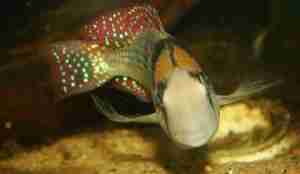
Gymnogeophagus are often seen as tropical fish in the cichlid section throughout most of the areas they are offered in the aquarium hobby. These cichlids are colorful and not particularly large. They are normally peaceful and very well suited for those beginning the hobby and for those wanting an easy setup. There are more than a dozen described species in the genus so finding one you like shouldn’t be difficult, other than actually finding one.
Most of the gymnogeophagus live in quieter waters. They tend to find quiet areas like smaller streams and lagoons to inhabit where they can eat fallen fruit, insects, larvae, and small crustaceans. They need a lot of roughage and chitin which can be found in green plants and the shells of crustaceans. High quality flake and frozen foods will do well in the aquarium. They are adapted to eat from the bottom so when feeding earthworms or mussels chop the pieces finely as they may have trouble with them whole or in large parts.
These fish are almost all suitable for maintaining and breeding in an unheated aquarium. their usual range is from 60 degrees to 77 degrees. These fish can tolerate temperatures between 46 and 86 degrees F. In their natural locations the temperature varies similarly and the fish need this natural variation seasonally to remain healthy. The winter temperatures of these fish in their natural ranges are can be 46 to 61 degrees. G. balzani populations do occur much deeper into to Brazil and they will need slightly warmer temperatures.
I have kept at least 5 species, and found if kept at tropical temps all year round, they become prone to disease and fungal infections. So I started putting Gymno gymnogenys “yerbalito” in my unheated basement in the winter. Temperatures would dip into low 50s and high 40s F. When they came out in spring they’d color up very brightly, and spawn almost immediately. – Duane Stuermer
During the summer these fish can tolerate water as high as 86 degrees without problems. The winter cooling period is not only normal but is needed. When kept year round at higher tropical temps like most keep heated tanks, they tend to get disease. They need a winter rest. In the unheated tank or basement they are treated to a winter break of 60 degrees for 2 or 3 months. This is a normal cycle for them and helps keep them healthy and also primes them for spawning.
Some have had great success with keeping their gymnogeophagus in outdoor ponds feeding flake and whatever grows in the ponds as a natural food. For the winter break they are brought indoors to an unheated basement or aquarium. Often many small juvenile fish from successful breedings are discovered during this period of cleanout ranging from ½ to ¾ of an inch. Often when introduced to the pond in the warming trend they will spawn naturally.
Most larger species like G. australis, G. balzanii, G. gymnogenys, and G. labiatus can be kept in a 55 gallon or smaller is small groups or harems. Smaller species like G. rhabdotus, G. meridionalis, G. sp. “Catalan,” will do well in a 30 gallon. Tetras of medium size, corydoras, and ancistrus can make good tankmates provided they too come from cooler waters.
The best substrate for gymnogeophagus is a smooth sand as they sift through the sand constantly. Coarse or sharp gravel and sand should be avoided to provide a more natural environment for your fish. Doing so will allow them to exhibit a more natural behavior. Plants are not going to grow well in a sand substrate with fish that love to dig and tunnel. Your best option would be wisely placed potted plants.
Moving and sifting sand constantly can create more particles in the water. For this reason a good filter should be used. Whether a canister filter or a hang on back is used is not a major issue over preference to you. Some fish may like more current and some fish less so take that into consideration when using powerheads.
Some of the gymnogeophagus are larvophilic mouthbrooders meaning that they pick up the wrigglers after the eggs hatch. Others spawn in open substrate which lay their eggs on the surfaces of roots or stones.
It is not only the gymnogeophagus that can be kept without a heater. Many subtropical species are out there. Getting them into the hobby is likely the biggest obstacle though. Cichlids, catfish, tetras, and others are suitable for an energy efficient aquarium for the modern home interested in aquaria and energy efficiency.
image by Duane Stuermer
 Biotope One A Study of Flora and Fauna
Biotope One A Study of Flora and Fauna 


